Chris Baty's Blog, page 128
March 6, 2017
NaNo YWP: Getting Students Excited About Writing
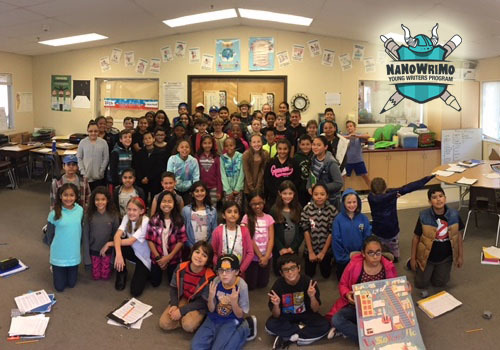
In addition to the main NaNoWriMo and Camp events each year, NaNoWriMo provides free creative writing resources to educators and young participants around the world through our Young Writers Program. Today, educator Amber Hummel shares the success story of her class:
The first time I discovered NaNoWriMo was through my sister. She heard about the program and told me about it. I loved to write as a kid and actually wrote a novel at 17. We decided to participate in NaNoWriMo and have never looked back. I am now an 8 time winner between November and various Camps.
When I heard that there was a Young Writer’s Program I knew I had to implement it in my classroom. I had already been doing a Young Author project each year, but spending the month writing a novel and setting their own word count goal sounded like something my students would love.
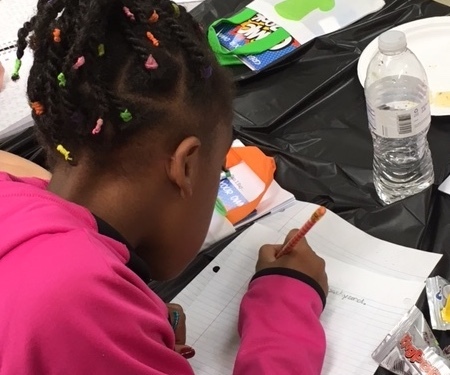
I base my curriculum on Chris Baty’s No Plot?, No Problem!. We use the steps outlined in that book to create our novels. The kids have the opportunity to write for an hour each day during November.
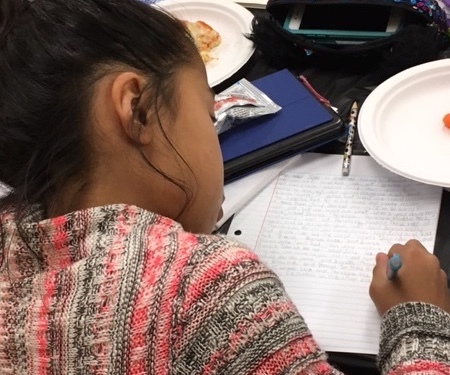
Last year my sister and I put on our very own Night of Writing Dangerously for my students, as well as an optional Saturday Write-In. The fact that almost 35 kids are willing to come to school on a weekend and spend hours writing has been really exciting! We get a higher turnout each time.
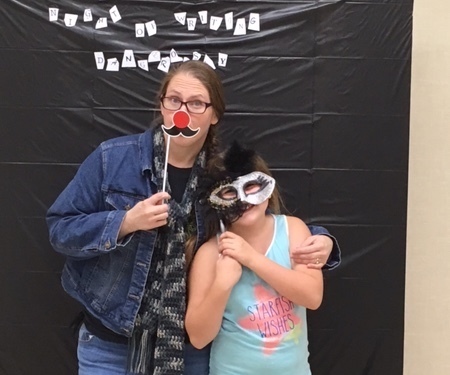
My advice to educators who want to use the Young Writers Program in their classroom is to let the kids see that you’re excited about the program and do it with them. Also, all plots are fair game. Don’t put a limit on their stories or a box around their ideas. The impact I have seen is that kids who hated writing and struggle with a short summary are cranking out thousands of words easily. And they are excited to do it.

My name is Amber Hummel and I teach 4th, 5th, and 6th grade at Antioch Charter Academy in Antioch, California. I have been teaching for 12 years. I myself am a NaNoWriMo participant and have two books published through CreateSpace, one an intermediate book under the name A.M. Hummel.
March 3, 2017
Screenwriting: How to Use Every Inch of Real Estate on the Page
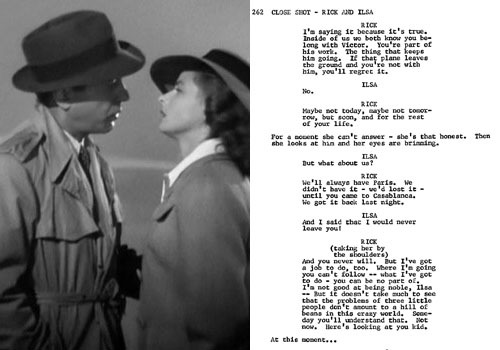
We’re getting ready for Camp NaNoWriMo this April! This month, we’re talking to Wrimos who are using the Camp format to work on non-novel projects. Author, editor, and screenwriter Julie Gray shares some writing tips that working on screenplays has taught her:
Screenwriting is a form of writing that is almost universally under-estimated. This probably has to do with the immersive, satisfying experience of seeing a film–and who doesn’t love a good movie? Writing one seems easy, right?
Wrong. What seems like a series of images and dialogue flying by is actually very demanding to write for a number of reasons. The format of screenwriting itself is totally unforgiving. But the biggest challenge for screenwriters–and there are many–is that they have very little time in which to tell their story.
A feature script should be at the most, between 100-120 pages long. For you prose writers, that’s maxing out at around 24,000 words. For the whole story. Compare that word count to a novel of say 100,000 words. And yet screenwriters have to do the same thing novel-writers do: backstory, subtext, plot twists, character development and theme. In a fraction of the words.
Because the competition is so tough, with hundreds of scripts landing in Hollywood every day for consideration, there is no room for variation or error. Hollywood readers are notoriously brutal. I should know. I used to be one.
These extremely challenging conditions give screenwriters a distinct advantage, however. They are, in a word, very muscular writers. Screenwriters must distill words into as powerful a vehicle as they can to convey not just narrative, but the emotional ride of a narrative, in as few words as possible.
“Don’t miss even one opportunity to ensure that your narrative evokes emotion and gets us to think and to feel.”Prose writers can do well to read scripts and behold the expediency with which screenwriters “show don’t tell”. Screenwriters must rely on conveying the most subtext, emotion, and atmosphere possible in the least amount of words. For screenwriters, characters never walk into a room. They mince, they sidle, they march, slide or slither. That walk–simply entering or exiting a scene–has to matter. It has to say everything about that character in that moment. Screenwriters simply don’t have the real estate to expand on the way a character moves or how the rain feels.
That is what screenwriters can teach prose writers–use every inch of real estate on that page; don’t miss even one opportunity to ensure that your narrative evokes emotion and gets us to think and to feel.
If you are a prose writer and are not familiar with reading a film script, the experience can be a bit frustrating. Scripts are written in a particular format, with “slug lines” and voice overs, etc. that you may find confounding. But if you read the “action lines” (anything that’s not dialogue or a slug line) you will quickly see how fewer words can sometimes have a bigger impact.
Overall, prose writers are in a better position than screenwriters, despite the seeming glamor of writing for the screen. Your stories will get read. But for a screenwriter, the only people who will read their story are agents, story analysts, and, if they are lucky, a producer. But if the story does not get purchased and produced and distributed, nobody will ever hear that story. It goes without saying that the number of scripts that grab the brass ring is vanishingly small compared to the number of scripts submitted.
Prose writers will share their stories on at least some level, whether you publish traditionally or self-publish. Even if the only people who read your story are your family or your friends. Your story did get out there. This is not the outcome of stories for the vast majority of screenwriters.
So before you get stars in your eyes about screenwriting as a writing path, take a cue from the way screenwriters write, and apply that potency to your prose. One good resource for perusing produced scripts is the BBC Writer’s Room. Get your story out there!

A former Hollywood story analyst living in Tel Aviv, Julie Gray is a UNESCO media literacy advocate in the Middle East and edits fiction and non-fiction manuscripts from writers all over the world. Her book Just Effing Entertain Me is a go-to for both screen and prose writers. A long time Huffington Post and Script Magazine writer, Julie is currently writing a non-fiction book describing life abroad and the curiously intertwined nature of national and personal identity.
Julie’s Facebook Group, the Fabulists, is for writers of all mediums, who find it self-evident that stories matter, words rock, and that writers need more coffee. Visit Julie’s website or follow her on Twitter @JulieGray972.
Top photo of Casablanca, via Writers Guild of America, West.
March 1, 2017
Get ready for Camp NaNoWriMo this April!“What’s that?” you...
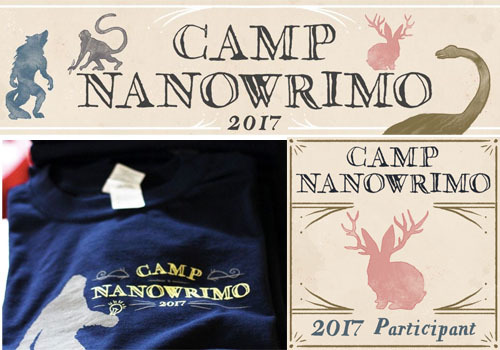
Get ready for Camp NaNoWriMo this April!
“What’s that?” you ask?
It’s a virtual writers’ retreat where you can nurture any writing project, novel or not, set your own word-count goal, and create a cabin cohort of fellow authors. Come check out Camp NaNoWriMo, and let your imagination run wild!
Learn more about Camp NaNoWriMo, or view some of our FAQ’s.
February 27, 2017
Now What? Don’t Give Up on Your Goal
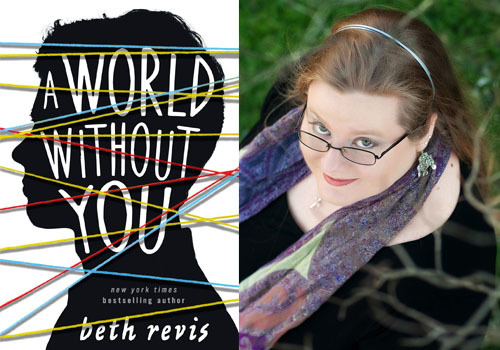
During January of our “Now What?” Months, we’re talking to Wrimos who’ve published their NaNoWriMo projects and asking them how they got there. Today, Beth Revis, best-selling author of the Across the Universe series and A World Without You , shares her story about the long, long process of getting published:
Ten.
Ten is an important number to me.
It took me ten novels before I wrote one worth publishing. Those ten novels took me ten years collectively to write. And there were rejections. More than ten. More than a thousand.
Here’s the most important thing I learned in that decade of trying—and failing—to be published:
Have a goal.That sounds so trite. (Although not, perhaps, as trite as “Never give up!” which may have been the more obvious thing to write. But I’m not writing that. Because if you want to be an author, that’s a given.)
But here’s the thing. Having a goal—a very specific goal that I could either reach or not—helped more than anything else. For me, my goal was the traditional path: agent, publisher, book deal. Having that goal helped me to move on. If I couldn’t get an agent with the first book, I’d write another. And another and another. There were other options—self publishing, smaller presses, quitting. But those options were not my goal.
I learned other things. Tricks of the trade that you pick up as you go:
Copy and paste the first five pages into the bottom of your query in order to give the agent a sample of your writing. Query in batches—if you get nothing but form rejections, then your query needs work; if you’re getting rejected after the sample, then your pages need work. Join the community—writers love to help writers (or at least the decent ones do).But I learned one other things that’s really important:
Failure is not your enemy.Failure is, in fact, a good thing. Failures makes you work harder. It makes you give a damn. It forces you to learn, to grow.
If your goal is clear and strong enough, failure cannot break it. If you fail long enough, and you don’t let that failure stop you, then nothing can stop you.
Beth Revis is the author of the NY Times bestselling Across the Universe series, The Body Electric, the Paper Hearts series and A World Without You! Never miss a thing: sign up for Beth’s monthly newsletter or visit her website at www.bethrevis.com.
February 24, 2017
I Published the NaNo-Novel That Didn’t Win

During our “Now What?” Months, we’re talking to Wrimos who’ve published their NaNoWriMo projects and asking them about the steps they took to make it happen. Today, participant Emily Nakanishi shares what she’s learned about the ups and downs of small publishing, self-publishing, and the different ways stories are meant to be told:
November of 2012 was an incredibly busy time for me. I was in my first year of college, in a creative writing class with a difficult teacher, and everything was incredibly overwhelming at the time. I wasn’t even sure that I could participate in NaNo, but I hadn’t skipped a year yet and I wasn’t about to start.
I remember that I wrote Your Heart Was a Legend in the first five or so days. I had planned to write something about growing up gay in small town America–what came out was ten thousand words of a character in love with his mostly straight best friend. It was when I finished the paragraph that would become the ending that I realized it was two in the morning, and I had a short story due in my creative writing class the next day. So I did what any exhausted college student in my situation would do–I printed off and turned in my NaNo novel.
When it came down to it, I fell in love with Your Heart Was a Legend and put so much time into polishing and perfecting it that I wasn’t able to finish NaNoWriMo that year, and that’s okay. It taught me a valuable lesson: Some stories are meant to be told in fifty thousand or a hundred thousand words. This story was meant to be told in ten thousand.
Publishing was an entirely different beast than writing. I guess I was used to being on top of the class, being a big fish in a small school. I’ll be the first to tell you that I don’t take criticism well (although I’m getting better), and so those first rejections were hard. My story was rough and abrasive, with obscene language, and it couldn’t be picked up by regular romance writers–the romantic quality just wasn’t there. “It’s too realistic,” one editor told me.
From this I learned two things. One, the story has to match the editor’s curtains that day–meaning whether or not you get accepted is all up to that editor in question. Two, for every rejection I got, I put my big girl pants on, and I sent it out to two more publications. Finally, I got a hit, from a small publishing company focused on LGBT+ stories.
“Remember that you’re doing this because you love writing, and keep that love alive as you go.”I won’t say it’s been all sunshine and rainbows, because it hasn’t. Small publishing companies are, in fact, small, and I maybe made $50 total off of my book. I was unused to the world of marketing, so that’s partly on me. Now, my publishing company is going under, which means that I have a novel that’s been previously published, and only a select few publishing companies want that.
So this time, instead of going through the hassle of getting rejection after rejection, I’ve self-published with Kindle Direct. While this method isn’t right for every book, I certainly feel it’s worth a try for this one, maybe with some better marketing on my end.
Really, I only have a little advice for when you decide to publish. Whatever you do, don’t give up. You’ll find that editor that loves your story; it may just take a few tries. If your publishing company doesn’t do much marketing for you, then pick up the slack. Make a Goodreads author page, make a Facebook page, make a Tumblr. And lastly, remember that you’re doing this because you love writing, and keep that love alive as you go. The game doesn’t end with publishing, it only ends when you stop writing.

Emily Nakanishi is a perpetual student working to get a degree in writing. She spends most of her days scrolling through Tumblr and trying to find inspiration for her many hobbies. She currently lives in Missouri with her two cats. She actively encourages people to come say hi, so stop by her Tumblr anytime at inmywilderness.tumblr.com. Her novel, Your Heart Was a Legend, is currently available on Amazon.
Top photo by Flickr user Tim Norris.
February 22, 2017
Top 10 “Do”s and “Don’t”s of Writing a Query Letter

You wrote a novel! Now what? NaNoWriMo’s “Now What?” Months are here—this February, we’ll be helping you guide your novel through the publishing process. Today, literary agent and editor Elizabeth Kracht shares her definitive list of things you should and shouldn’t do when querying:
Query letters are your calling card
in publishing and shouldn’t be underestimated. They’re pretty hard for authors
to write because they’re technical pieces of writing, not creative. I’m a
fairly relaxed agent, and our agency allows unsolicited submissions, but some
agencies only want to see the query, which means you’ve got one shot. Here are my top ten query letter “Do’s and Don’ts” to help your query letter stand out–in a good way.
1. Address
the agent as you would in a business letter: Dear. Mr. or Ms. Blank:
2. Give
one line about why you think your work may be a good fit for this agent.
3. Have
your next line lead with the genre, title, word count, and two comparable
titles (books similar in style to yours).
4. Create
a summary paragraph of your novel (150-200 words). Be economic with words and introduce your
main character, setting, and inciting incident in the first line. In the summary,
tell us what sets your character off and what continues to drive the story and
characters forward. Give us a sense of what’s at stake for your main character
and add a couple of additional plot points. Make sure there is a sense of
tension and urgency in your summary, and end it at a climactic point.
Here’s an excerpt
of what I used to pitch my author Danny Gardner’s historical thriller A Negro and an Ofay:
On
the run after killing two crooked cops, disgraced Chicago PD Detective Elliot
Caprice finds himself in a jailhouse in St. Louis on false charges. He enlists
friends from his hometown of Southville, IL, to secure his release and returns
to find the family farm in foreclosure and the man who raised him dying in a
flophouse. Consumed with guilt over his past crimes and desperate for money, he
accepts a straight job as a process server for a civil rights attorney and
eventually crosses paths with a powerful family from Chicago’s North Shore…
5. Tell
us about yourself in an author bio (75-100 words) listing where you live, any
degrees, your job, writing credentials or published works, your author website
address, and whether you are active across social media. This section will be
larger for some and shorter for others. If you don’t have much to place here,
simply say something like you’re a debut author living in X and your website can
be viewed at Y.
6. Address
your query to more than one agent at a time. Chain email submissions are
deleted.
7. Oversell
or undersell yourself. Take the middle path. Most authors do one or the
other—claim to be the next J.K. Rowling or that they’re a “nobody.” Those authors
who don’t oversell or undersell themselves really
stand out.
8. Use
gimmicks to get our attention. Sometimes authors are too conversational and
informal in their approach and language. Again, think “business letter.” When we
read a straightforward, well-written query letter, we sit up straight.
9. …Forget
to attach your materials and double-check for typos! Our agency uses a
submission form, so we won’t let you forget your materials, but other agencies
may not. And don’t get rejected for typos in your query. Double-check everything
before you hit send!
10. Be
ungrateful or discouraged if you receive rejections. Rejections, from our end,
are not personal. There can be any number of reasons why we reject a project (from
a full list or illness to the need for development, we have a similar project,
and more). Know there are hundreds of agents out there, and new ones blossoming
all the time. So don’t take it personally. Don’t give up. Say thank you. And keep
submitting your work until you find your person.

Elizabeth K.
Kracht is a literary agent with Kimberley Cameron & Associates and a
freelance developmental editor. Her websites can be viewed at www.elizabethkracht.com and www.kimberleycameron.com.
Top photo by Flickr user Francisco Martins.
February 21, 2017
Taming the Octopus: How to Self-Publish Without Getting Squeezed

You wrote a novel! Now what? NaNoWriMo’s “Now What?” Months are here—this February, we’ll be helping you guide your novel through the publishing process. Today, author Ruth Kaufman shares her self-publishing wisdom on taming the denizens of those stormy writing seas:
Some authors love having control that goes along with self-publishing, but the self-pub industry sometimes reminds me of a giant octopus: Each waving tentacle is a different facet of the publishing process. I struggle to tame the octopus in an endless sea of information and options, beneath a learning curve stretching well beyond the horizon.
When I finished my novel, I thought I was ready to go, but found that before I could step forward, I had to take several steps back–and that most steps took longer than I thought. Through my experience, I learned a few key components of self-publishing. Here are some questions you should answer as you work toward your self-publishing goals. I could give a workshop or two on each one. I hope these help you on your journey!
1. Create a business plan.Congratulations! You’re an entrepreneur. Consider money and time budgeting: how much can you do yourself, how much will you farm out, and to whom. What are your goals: holding your book in your hands, seeing it online, or earning money? On that note, what does “earning money” mean to you: covering costs, paying yourself a salary? Schedule your publications–decide how many projects you’re working on, what genres they’ll be, and how often they’ll come out.
2. Get your book ready to publish.Yours shouldn’t be the only eyes on your manuscript. Decide how many beta readers you want, and who they will be. Decide which kind(s) of editor(s) you need and reach out to them (You DO need one or more editor(s): developmental, content, copy, line and proofreader). Who will handle your book’s formatting? (The options are different for e-book and print, and even sites like Amazon, B&N, Apple). Choose keywords. Create front and back matter (such as blurbs, author bio, etc.)
3. Create a cover design.An amazing cover is vital. Study where your book fits in online stores and lists; look at the competition in your genre(s) and sub-genres. Just as important, learn what you like and don’t like: what kinds of covers do you find yourself drawn to? You can find a designer via recommendations and/or browsing portfolios, and work with them to choose elements from tone to colors to cover models to images to fonts. (Chances are this will take longer than you think, and the designer you want might not be available when you’re ready.) Pro tip: How does the cover look in thumbnail size, which may be the only thing most readers see?
4. Consider distribution.Figure out whether you would like to publish in E-book, print, or both. Who will produce them? Options include IngramSpark, Amazon’s CreateSpace and Kindle Direct Publishing, and Draft2Digital. What price will you charge? Will you go wide (requiring some knowledge of the options) or be Amazon exclusive (so you can be in KDP Select/Kindle Unlimited), Who will handle the uploading? Are you trying to get into stores? Libraries? Available for pre-order or not?
5. Plan your release and discoverability.Publicity matters! You have many tools to use toward this end: promotion, marketing and networking, website, social media, local press, blogging/guest blogging, etc. Set up your pages, such as Amazon Author page and your Goodreads profile. Newsletters are a surprisingly effective tool. You can research how to grow and manage your list, what to put in a newsletter to increase your open rates, and which provider to use.
Do you want ads? if so, where and how many? (Facebook, Amazon Marketing Services, Goodreads, etc.). These don’t just have to be for your book: they can be for signings, giveaways, or contests for readers and reviewers. Reviews are helpful, but most well-known publications/bloggers require a proof copy months in advance. Figure out what you can do to stand out amidst the thousands of new releases every month.
6. Go it alone or partner with other authors.Sometimes, you can share the heavy load of time, cost, and decision with other authors. You can consider releasing boxed sets of both your works, joint promotions and/or giveaways, co-hosting events, and group blogs. Not only do you cut the work in half, but you both broaden your audiences. I’ve had more success when partnering than on my own.
7. Keep up with the fast-changing market.Find informative Facebook groups, blogs, podcasts, and Twitter accounts to follow. Often, authors or publishers will have a newsletter you can subscribe to that will share the tips and resources that they use. Consider signing up for workshops or classes that could help you build skills you feel less confident about. Mark Dawson is one name that keeps coming up, and JA Konrath is another.
8. Consider next steps.Novellas and short stories can be a way to increase your output in less time. You can make something perma-free, or temporarily free, and use InstaFreebie or BookFunnel. You can also use Amazon features such as Kindle Worlds or Kindle Singles.
Analyze the success that you had from your last project. Did you accomplish the goals you set out to make? If not, what could you/are you willing to do differently next time around? Maybe you would like to try pursuing traditional publishing, or a hybrid of traditional and self-publishing. Try to expand your reach (and maybe get a contract) via sites like Kindle Scout or Wattpad.

Ruth Kaufman is the author of the Wars of the Roses Brides trilogy and My Once & Future Love. Accolades include 2016 Booksellers’ Best Awards Best Historical and Best First Book winner, and Romance Writers of America® Golden Heart® winner. She’s also an actor and voiceover talent, freelance editor, and storyteller with a J.D. and a Master’s in Radio/TV. She enjoys peanut butter and chocolate milkshakes and singing in a symphony chorus. Learn more at www.ruthkaufman.com and www .ruthtalks.com. You can also visit her Amazon Author Page, Blog, Facebook, Twitter, and Goodreads.
Top photo by Flickr user Ray Sadler.
February 17, 2017
Books That Changed My Life: Learning How to Write Out Loud
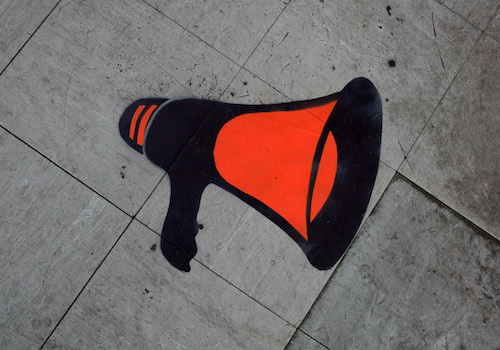
We’ve started a new blog series where NaNoWriMo participants can share their experiences with books that have changed their writing–and their world-views–for the better. And what better way to kick off a new series than to continue celebrating Black History Month? Today, TommehBell, Municipal Liaison for the USA :: North Carolina :: Triad region, shares her thoughts on a book that helped her embrace her voice and identity:
I took my first creative writing class as a sophomore in high school. It was at the local community college and my mom had to drop me off because I didn’t have a car yet.
I’d rewritten “Sleeping Beauty” with a black girl as Briar Rose and I was rather excited to read it in front of the class. My voice quivered and sweat dripped down into my bra. (Boob sweat is the worst, am I right?) I managed to make it all the way to the end without fainting.
The class gave me a round of polite applause before the critique began. A girl in the middle row threw her hand into the air: “It’s a decent story but black girls don’t really act like that.” I’m sure the rest of the class went on to say things I needed to hear, but that first comment was all that I took in. I never went back to that class. I stopped writing for nearly two years.
The first time I read The Coldest Winter Ever by Sister Soulja, I was a senior in high school, ready to cut the apron strings and experience the world as an adult. Being a hip-hop head of course I’d heard of Sister Soulja and I enjoyed her flow. I’ve always had a thing for female MCs. The way a woman rocks the mic gets me out of my seat each and every time. It was by chance that I picked up The Coldest Winter Ever. I was searching for Harry Potter and the Sorcerer’s Stone and the purple cover of CWE caught my eye. I’m an avid reader, and I devour books like air, and the first time I cracked the spine of CWE I was struck speechless.
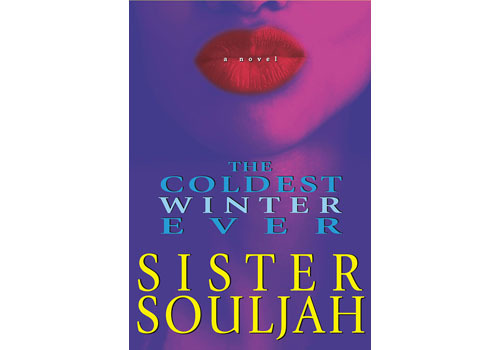 “I held a book that not only featured a cast of black people, but at its core was a book that didn’t apologize for being black.”
“I held a book that not only featured a cast of black people, but at its core was a book that didn’t apologize for being black.”I skipped school to read the book and then reread it all in one sitting. Sister Soulja penned a tale that changed the course of my writing journey. I held a book that not only featured a cast of black people, but at its core was a book that didn’t apologize for being black. It wasn’t a fairy tale with a prince and a happily ever after. The main character did a lot of people dirty–including her family–and got her comeuppance in the end. You felt sorry that she did and then you felt bad that you cheered for her downfall.
The book opens with the main character describing her birth: “I came busting out of my momma’s big coochie January 28, 1977.” It was the coldest winter in record history, hence her moniker. Winter Santiaga, Brooklyn born and bred, is a true product of the game. Born from the school of hard knocks, she is a hustler first and a diva second. Much like Henry in Goodfellas she learned the game sitting at the feet of her father, a kingpin of the drug game in the early 80s and 90s. Ricky Santiaga was the man to know, love, and work for if you wanted the good and easy life in the projects of New York. Winter’s attitude punches you square in the jaw on page one and the ride never goes smooth.
Before reading about Winter, I wanted my black characters to be ideal characters. I wanted them to fit into the white ideal I had spent my childhood reading about. I wanted them to be princesses, and damsels in distress. I wanted Prince Charmings and bold magicians. I wanted great characters that happened to be black. I thought it was a recipe for success. I was quickly informed that black characters aren’t princesses, and we can’t be Prince Charmings.
The Coldest Winter Ever helped me to write out loud. Winter helped me get over trying to shed the bad about being black. It helped me to write characters that are black and proud; characters that are bad and boujee or Harvard educated. I don’t have to play by society’s and literature’s rules about black characters. It showed me that I can use my authentic writer voice and that I don’t have to censure and erase my characters for mass consumption. I don’t need to write my characters in a certain way to help them cross over. Winter showed me that I can let my characters be themselves, no matter what anyone thinks.

TommehBell wrote her first story after she watched Michael Jackson moonwalk across her TV screen. She grew up in Germany as the oldest child of military parents. In 2010 she penned her first NaNo novel and the following year she became an ML and site mod. Since that first NaNo attempt Tommeh has received her BA and her first Masters. Currently she is working on a library science and information Masters and getting her MA manuscript published.
You can follow her on Twitter, Tumblr, and Instagram.
Top photo by Flickr user Leo Reynolds.
February 15, 2017
3 First-Time Self-Publishing Mistakes to Avoid
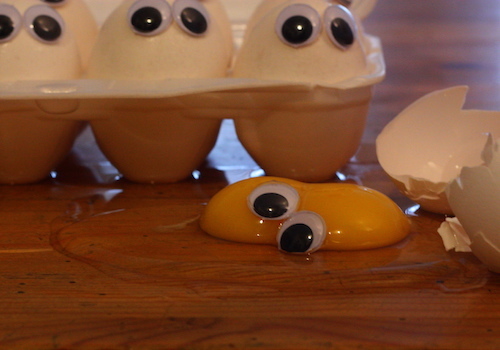
During our “Now What?” Months, we’re talking to Wrimos who’ve self-published their NaNoWriMo projects and asking them about the steps they took to make it happen. Today, participant and author Joaquín Pineda shares what he’s learned on the rocky road to self-publishing:
Finishing NaNoWriMo in 2008 felt like digging my fingers into the earth and flipping over a mountain. I grit my teeth until they chipped and I shaved years off my life expectancy.
Or at least that’s what it felt like, and with good reason. After twenty days of non-stop writing I put down fifty thousand words, more than anything I’d ever done before. The momentum was such that I wrote another sixty thousand by December 20th and completed the first draft of my novel MUTEKI – Sendero de los Campeones (Road of Champions). It was a suitable title for a project that almost singlehandedly rescued me from the pits of depression. In my mind I was a champion.
Or at least I was until I published the book and everything went to hell in a handbasket.
The aftermath of publishing my first NaNo novel in 2011 was a nightmare, a crime scene, a horror story. And that’s okay. I was exploring new territory, after all. Just as I was stumbling and fumbling through those first words on November 1st, 2008, I was stumbling and fumbling again as I faced new challenges.
So what went wrong? What was so catastrophic?
Don’t worry. I made you a list.
1. I delivered unpolished work.The people in charge of printing my book were crystal clear: you have to turn this in ASAP or else it won’t come out on time. This shouldn’t have been an issue. If I pitched the book that’s because it’s ready, right?
You’re forgetting that…
2. I never hired a proofreader/editor.This is embarrassing to say even six years after the fact, but I never bothered to look into paying an editor. Not even with “exposure”. I didn’t know one, I was broke, and I thought I would do a pretty decent editing job. Turns out I didn’t.
Looking back at the novel now, I’m noticing not only typos but pointless scenes, cringe-y dialogue, characters that change names halfway through, and–worst of all–sentences mangled by the “replace all” feature.
I promise to talk about this in depth if I ever get the chance. For now, let’s focus on my next mistake.
3. I didn’t ask for any proof copies.Proof copies are your best friends. Without those you can’t preview the final product. That’s why the inside margins of my book were off and some pages came up blank due to terrible formatting. Some of the books were even missing pages.
But hey. I had a book.
As you can see, my first publishing experience was the work of an amateur and it’s still a source of mild embarrassment to this day. I only say “mild” instead of “I am moving to the mountains never to be seen again” because those days were some of the best in my entire life. I went on local TV and radio, I read at various conventions, libraries and book stores, I shook hands and took pictures with the mayor, they wrote about me on newspapers, and I made connections so valuable that we still talk and work on projects to this day. And yes, I did finally meet some editors.
Best of all, I could finally puff out my chest and feel like a writer, albeit a terrible one. Without that confidence and passion I wouldn’t have turned all this into a positive; you would be reading this on a subreddit for embarrassing confessions instead. That same gusto is what helped me write five more novel manuscripts-–three of them NaNo victories–-and around seventy short stories, all of which are probably still crap but decidedly better than my earlier work.
You will make mistakes. Trust me. Thankfully for us this isn’t hard science. There are no goal posts. It’s all about being in love with the worlds and the friends and foes in your head and giving them that breathing space they’ve been screaming for like a nest full of annoying little baby chicks.
This is indeed the “Road of Champions” not because we’re invulnerable, but because we are Muteki–”invincible” in Japanese. We will stagger, we will fall, but at the end of the day and come what may, we will write on and make the best art we can.
Go on now. Get some scars. Make some mistakes.
Good luck!

Joaquín Alberto Pineda is the author of MUTEKI and the upcoming short story collection Parables From a Stressed Out Artist, both self-published. He’s influenced by the work of Ernest Hemingway, Fyodor Dostoyevsky, James Ellroy, Juan Rulfo, and Raymond Chandler, among others. Joaquín currently resides in Mexicali, Baja California, Mexico, where he works as a high school teacher. Visit his blog (in Spanish), Facebook (in Spanish), or Twitter (in English).
Top photo by Flickr user leasqueaky.
February 13, 2017
Now What? Where the Story Comes In
 You wrote a novel! Now what? NaNoWriMo’s “Now What?” Months are here—this February, we’ll be helping you guide your novel through the publishing process. Today, author and writing coach E.J. Runyon shares some writing tips to help you prepare your manuscript for a publisher’s eyes:
You wrote a novel! Now what? NaNoWriMo’s “Now What?” Months are here—this February, we’ll be helping you guide your novel through the publishing process. Today, author and writing coach E.J. Runyon shares some writing tips to help you prepare your manuscript for a publisher’s eyes:Here’s a big secret: storytelling is the opposite of telling.
Forget the duality of “Show, don’t Tell” rules. The secret is to do some storytelling, and your “telling” problem will likely fall away.
Did you write up scene notes before you began writing your pledged 50K words? If you did, what kind of verbs did you use in those notes? Are your notes or outlines written in strong, active verbs? Or do they look something like this:
Joseph will be at the door. Mary will be glad to see him.
If you didn’t write up scene notes at all, you may be writing by accident. And that’s the second place where telling can take over.
You can begin your first draft like this:
Joseph stood on her front porch but didn’t knock. The wind as it was coming from the east, made his eyes squint.
She opened the door. Saw him there, and she nodded and smiled. [34 words]
In one way, it’s a nice way to start. You aren’t over-using state-of-being verbs, like was or were, or the helpers words like as and had been, too much.
The verbs here are stood, knock, was, coming, made, squint, opened, saw, nodded, and smiled. But that is a lot of stage direction for the wind, Joseph and someone named “she”.
On second glance, you have to admit, these lines are mostly story facts. The “Where folks are”, the “What they did, movement-wise”. There’s not a lot of storytelling here yet.
We aren’t given many suggestions about anyone’s emotions, or motivations. There are no hints as to why we should be watching these folks, yet.
And those things are what storytelling’s all about. It seems like first drafts fall into the trap of “get the movements down first”. And they read like “story-notes” more than they do first tries at storytelling.
Let’s say you did write up some notes about the scene. But they were very much in the “this is what the story will be” style. How can we fix that “telling” type of opening now that it’s on the page?
Ask yourself some questions about what you want to show us–and then answer them! Go beyond the telling us stuff of story-facts and body-movements. Get into the why of things–emotions, motivations, reactions. That’s where the storytelling happens.
1. What’s Joseph feeling as he stands there?
Joseph’s nervous, that’s why he doesn’t just knock.2. What about the wind is so evocative that you felt it needs mentioning?
I’ll show that by how the wind makes him react.
3. This “she” you are telling us about, what’s making her smile and nod at seeing Joseph?
Mary, at the door, won’t unlatch the screen, but she won’t be able to stop from smiling because he’s there.
Now you have something to work with, for showing us the story behind these two folks at this door and on this porch.
Look at this compared to what we began with:
Joseph stood on Mary’s front porch, feeling like a soggy morning paper, limp and forgotten there. He wanted so much to be braver than he felt, but he couldn’t get himself to knock. The wind, from the east, felt like an icy finger poked into his ear, and it made his eyes squint and tear. At least, he told himself that was why his eyes felt wet.
She opened the door, surprised, but didn’t automatically reach for the screen’s latch like she would have yesterday. But Joseph could see the secret smile in her eyes as she nodded. Maybe there was hope after all. [104 words!]
By taking the original lines, asking the why behind them, and then using commas to expand your thoughts, you end up bringing in the storytelling to mix and mingle with your story-facts:
Joseph is feeling like a soggy morning paper, limp and forgotten there. This shows us there might be a problem somewhere.
The wind, an icy finger, poked into his ear, making his eyes squint and tear, is now nearly an inanimate character that makes Joseph react. The line that then follows makes sure we know there’s a problem here.
We then see Mary though Joseph’s eyes, not through the narrator’s eyes. This is a great way to show rather than tell the reader what’s going on in a storytelling way. We also see what Joseph’s thinking about when he sees Mary’s eyes. And we see that the problem might be solvable.
When you change story-facts that only “tell” into storytelling that “shows” the motivations behind the actions, not only does your writing improve, but your word count goes up!
Try this type of questioning with your story-facts as you edit your manuscript or prepare to send it to an agent or publisher: What is the motivation, and the meaning, behind the movements of your characters? Figure it out, add it to what you began with, and you’ll be expanding more than only your stage directions. You’ll be upping your word count and bringing in the story.

EJ Runyon’s been doing NaNo since 2001. She’s a writing coach and an author of 5 books, one is Tell Me (How to Write) A Story, here on the NaNoWriMo “Books We Like” page. All the others are NaNo projects that have been accepted by US & UK publishers. She runs Bridge to Story, a website offering 52 free writing lessons. Weekly she works with up to 24 new writers, so get in touch for a 1-on-1 Skype session if you like what’s above.
Top photo by Flickr user William Murphy.
Chris Baty's Blog
- Chris Baty's profile
- 63 followers



